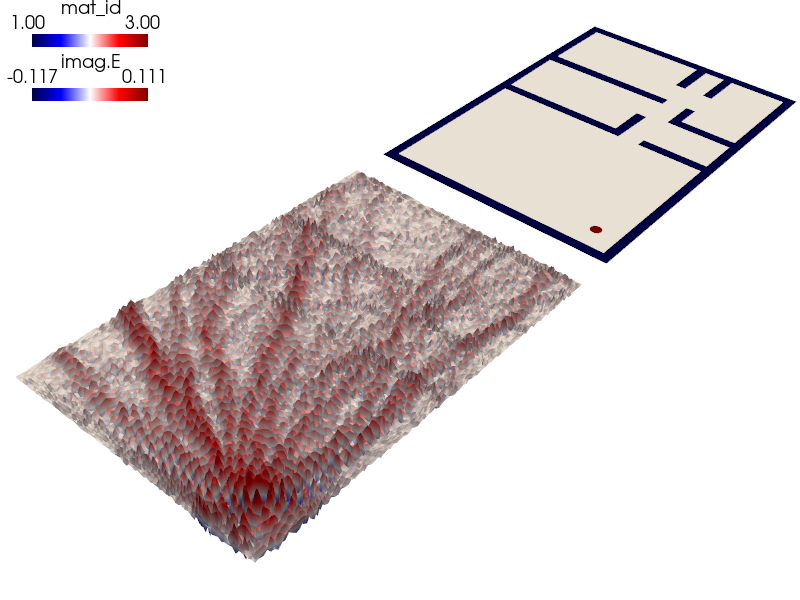acoustics/helmholtz_apartment.py¶
Description
A script demonstrating the solution of the scalar Helmholtz equation for a situation inspired by the physical problem of WiFi propagation in an apartment.
The example is an adaptation of the project found here: https://bthierry.pages.math.cnrs.fr/course-fem/projet/2017-2018/
The boundary conditions are defined as perfect radiation conditions, meaning that on the boundary waves will radiate outside.
The PDE for this physical process implies to find  for
for  such that:
such that:

Usage¶
The mesh of the appartement and the different material ids can be visualized with the following:
sfepy-view meshes/2d/helmholtz_apartment.vtk -e -2
The example is run from the top level directory as:
sfepy-run sfepy/examples/acoustics/helmholtz_apartment.py
The result of the computation can be visualized as follows:
sfepy-view helmholtz_apartment.vtk --color-map=seismic -f imag.E:wimag.E:f10%:p0 --camera-position="-5.14968,-7.27948,7.08783,-0.463265,-0.23358,-0.350532,0.160127,0.664287,0.730124"

r"""
A script demonstrating the solution of the scalar Helmholtz equation for a
situation inspired by the physical problem of WiFi propagation in an apartment.
The example is an adaptation of the project found here:
https://bthierry.pages.math.cnrs.fr/course-fem/projet/2017-2018/
The boundary conditions are defined as perfect radiation conditions, meaning
that on the boundary waves will radiate outside.
The PDE for this physical process implies to find :math:`E(x, t)` for :math:`x
\in \Omega` such that:
.. math::
\left\lbrace
\begin{aligned}
\Delta E+ k^2 n(x)^2 E = f_s && \forall x \in \Omega \\
\partial_n E(x)-ikn(x)E(x)=0 && \forall x \text{ on } \partial \Omega
\end{aligned}
\right.
Usage
-----
The mesh of the appartement and the different material ids can be visualized
with the following::
sfepy-view meshes/2d/helmholtz_apartment.vtk -e -2
The example is run from the top level directory as::
sfepy-run sfepy/examples/acoustics/helmholtz_apartment.py
The result of the computation can be visualized as follows::
sfepy-view helmholtz_apartment.vtk --color-map=seismic -f imag.E:wimag.E:f10%:p0 --camera-position="-5.14968,-7.27948,7.08783,-0.463265,-0.23358,-0.350532,0.160127,0.664287,0.730124"
"""
import numpy as nm
from sfepy import data_dir
f = 2.4 * 1e9 # change this to 2.4 or 5 if you want to simulate frequencies
# typically used by your Wifi
c0 = 3e8 # m/s
k = 2 * nm.pi * f / c0
filename_mesh = data_dir + "/meshes/2d/helmholtz_apartment.vtk"
regions = {
'Omega': 'all',
'Walls': ('cells of group 1'),
'Air': ('cells of group 2'),
'Source': ('cells of group 3'),
'Gamma': ('vertices of surface', 'facet'),
}
# air and walls have different material parameters, hence the 1. and 2.4 factors
materials = {
'material': ({'kn_square': {
'Air': (k * 1.) ** 2,
'Walls': (k * 2.4) ** 2}, },),
'boundary': ({'kn': 1j * k * 2.4},),
'source_func': 'source_func',
}
def source_func(ts, coors, mode=None, **kwargs):
"""The source function for the antenna."""
epsilon = 0.1
x_center = nm.array([-3.23, -1.58])
if mode == 'qp':
dists = nm.abs(nm.sum(nm.square(coors - x_center), axis=1))
val = 3 / nm.pi / epsilon ** 2 * (1 - dists / epsilon)
return {'val': val[:, nm.newaxis, nm.newaxis]}
functions = {
'source_func': (source_func,),
}
fields = {
'electric_field': ('complex', 1, 'Omega', 1),
}
variables = {
'E': ('unknown field', 'electric_field', 1),
'q': ('test field', 'electric_field', 'E'),
}
ebcs = {
}
integrals = {
'i': 2,
}
equations = {
'Helmholtz equation':
"""- dw_laplace.i.Omega(q, E)
+ dw_dot.i.Omega(material.kn_square, q, E)
+ dw_dot.i.Gamma(boundary.kn, q, E)
= dw_integrate.i.Source(source_func.val, q)
"""
}
solvers = {
'ls': ('ls.auto_direct', {}),
'newton': ('nls.newton', {
'i_max': 1,
}),
}
options = {
'refinement_level': 3,
}